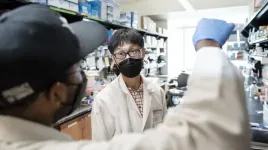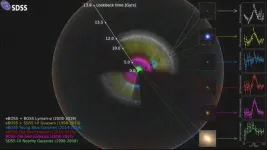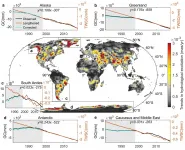(Press-News.org) DURHAM, N.H.-- Corals and sponges are important foundations in ocean ecosystems providing structure and habitats that shelter a high number of species like fish, crabs and other creatures, particularly in the seamounts and canyons of the deep sea. Researchers at the University of New Hampshire have discovered that when it comes to climate change not all deep-sea corals and sponges are affected the same and some could be threatened if average ocean temperatures continue to increase in the deep sea of the Northwest Atlantic.
"These deep-sea corals and sponges are ecologically important because they are foundational species that contribute to the food web and losing them could eventually lower the biodiversity of the deep sea," said Jennifer Dijkstra, a research assistant professor in UNH's Center for Coastal and Ocean Mapping.
In their study, published in the journal Global Ecology and Biogeography, the researchers combined data about temperature, dissolved oxygen, salinity and depth with high-resolution underwater video of the seafloor. The video was collected by a remotely operated vehicle (ROV) along the Northeast Canyons and New England Seamount Chain by the National Oceanic and Atmospheric Administration (NOAA) Ocean Exploration and Research branch. The researchers analyzed the data and annotated the ROV video to determine the density of the corals and sponges in specific areas, allowing the scientists to identify their location. They linked environmental variables to emerging patterns and high densities in narrow environmental ranges. Although corals and sponges co-occur, climate-related variables temperature, salinity and dissolved oxygen contributed to the distribution of sponges, whereas seafloor properties of slope and substrate contributed to the distribution of corals.
"The paper shows that not all deep-sea corals and sponges were influenced by the same environmental variables and each has different levels of sensitivity," said Dijkstra. "Changes in temperature and dissolved oxygen, that go beyond what the deep-sea corals and sponges are used to, could stress the species' physiology affecting growth, tissue loss and reproduction."
In general, deep-sea corals are found 200 to 10,000 feet below sea level where sunlight is nonexistent. Unlike shallow-water coral reefs, which are limited to warm tropical waters, deep-sea corals are found throughout the world's oceans, from tropical to polar regions, forming groves of tree or fan shapes that can reach feet to meters tall. Deep-sea sponge populations can filter water, collect bacteria and process carbon, nitrogen, and phosphorus. Deep-sea corals and sponges have been found on continental shelves, canyons and seamounts in deep seas around the world but their full extent is unknown because only 15 percent of the Earth's seafloor has been mapped with high-resolution imaging.
INFORMATION:
The University of New Hampshire inspires innovation and transforms lives in our state, nation, and world. More than 16,000 students from all 50 states and 71 countries engage with an award-winning faculty in top-ranked programs in business, engineering, law, health and human services, liberal arts and the sciences across more than 200 programs of study. As one of the nation's highest-performing research universities, UNH partners with NASA, NOAA, NSF and NIH, and receives more than $110 million in competitive external funding every year to further explore and define the frontiers of land, sea and space.
ITHACA, N.Y. - House finches are locked in a deadly cycle of immunity and new strains of bacterial infection in battling an eye disease that halved their population when it first emerged 25 years ago, according to new research from the Cornell Lab of Ornithology.
House finch eye disease causes red, swollen, watery or crusty eyes. Afflicted birds can recover, but may die because they cannot see well enough to find food or avoid predators. The latest analyses, based on the observations of Project FeederWatch participants from eight Northeast states, addresses the long-term ...
A recently published article in the Molecular Plant-Microbe Interactions journal provides new evidence that pathogens are hijacking the plant immune system to cause disease while providing insights into a newly discovered mechanism.
A large variety of pathogens infect plants and cause different diseases, which can lead to reduced crop yields. During infection, pathogens secrete effector proteins into the plant cell. Some of these proteins target plant proteasomal degradation machinery, which is responsible for recycling proteins to regulate cell processes. Some E1, E2 and E3-ligase proteins have been identified as playing a role in plant susceptibility ...
PHILADELPHIA, PA - The first National Institutes of Health (NIH) National Cancer Institute (NCI)-funded clinical study examining stereotactic body radiotherapy (SBRT) in the treatment of oligometastatic breast, prostate, and non-small cell lung (NSCLC) cancers displayed evidence that SBRT can be safely used to treat patients who have multiple metastases. These results were recently published in JAMA Oncology.
The results of the Phase I NRG-BR001 trial, conducted by the NCI National Clinical Trials Network group NRG Oncology, indicate that SBRT treatment in ...
SAN FRANCISCO, CA--April 22, 2021--In their effort to understand the very earliest stages of life and how they can go wrong, scientists are confronted with ethical issues surrounding the use of human embryos. The use of animal embryos is also subject to restrictions rooted in ethical considerations. To overcome these limitations, scientists have been trying to recreate early embryos using stem cells.
One of the challenges in creating these so-called synthetic embryos is to generate all the cell types normally found in a young embryo before it implants into the wall of the uterus. Some of these cells eventually give rise to the placenta. Others become the amniotic sac in which the fetus grows. Both the placenta and the amniotic sac are crucial for the survival of the fetus, and defects ...
A new research paper examining the relationship between the Omega-3 Index and risk for death from any and all causes has been published in END ...
The extended Baryon Oscillation Spectroscopic Survey (eBOSS) collaboration has released its latest scientific results. These results include two studies on dark energy led by Prof. ZHAO Gongbo and Prof. WANG Yuting, respectively, from National Astronomical Observatories of the Chinese Academy of Sciences(NAOC).
The study led by Prof. Zhao was recently published in Monthly Notices of the Royal Astronomical Society.
Based on eBOSS observations, Prof. ZHAO's team measured the history of cosmic expansion and structure growth in a huge volume of the past universe, corresponding to a distance range between 0.7 and 1.8 billion light years away from us. This volume had never been ...
A joint research study by the Pacific Water Research Centre at Simon Fraser University and the Fraser Basin Council points to the use of certified, nature-based solutions for protecting salmon and aquatic habitats in the Lower Mainland.
Salmon face various threats in the Lower Fraser Watershed (where the Fraser River passes through the Metro Vancouver geographical area), including habitat loss due to urban development and toxic stormwater runoff, which is projected to worsen due to climate change-driven extreme rain events.
The END ...
Like tree rings, cave stalagmites are a portal to a prehistoric Earth, and now scientists from UNSW Sydney have found they are consistently reliable as time trackers the world over.
In a global investigation into the growth properties of stalagmites distributed across the world, the scientists found that while growth fluctuations due to climate events are evident in the shorter period, stalagmite growth over the longer periods - tens of thousands of years - are surprisingly linear.
"Our new global analysis shows that we can consider stalagmite growth as being like a metronome and very ...
WASHINGTON-- Glacial melting due to global warming is likely the cause of a shift in the movement of the poles that occurred in the 1990s.
The locations of the North and South poles aren't static, unchanging spots on our planet. The axis Earth spins around--or more specifically the surface that invisible line emerges from--is always moving due to processes scientists don't completely understand. The way water is distributed on Earth's surface is one factor that drives the drift.
Melting glaciers redistributed enough water to cause the direction of polar wander to turn and accelerate eastward during the mid-1990s, according to a new study in Geophysical Research Letters, AGU's journal for high-impact, ...
CHAMPAIGN, Ill. -- Attempts at restricting people's mobility to control the spread of COVID-19 may be effective only for a short period, researchers said. A new study examines people's mobility for seven months during the pandemic in the United States using publicly available, anonymized mobile phone data.
Reported in the Journal of Transport Geography, the study alerts authorities to the need for more manageable travel restrictions and policies that reduce COVID-19 exposure risk to essential workers - who, because they are required to be physically present at their workplaces, remained highly mobile during the pandemic.
The longitudinal study is one of the first to compare mobility data using a broad ...



